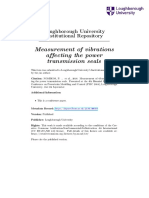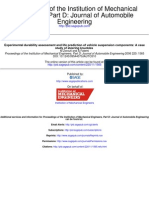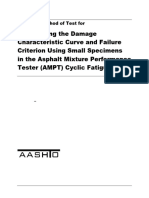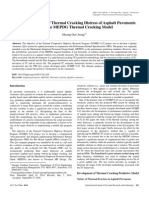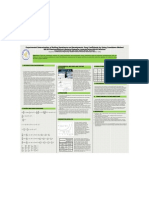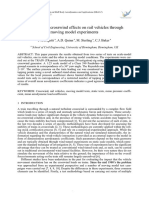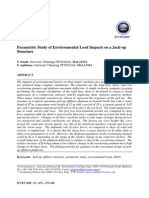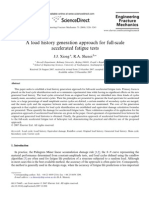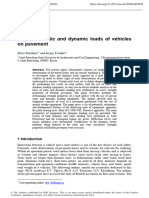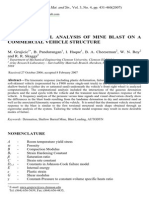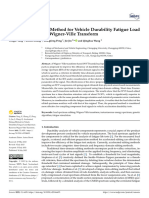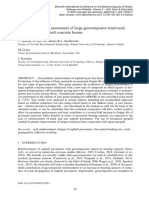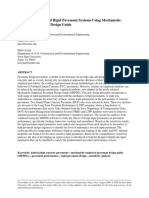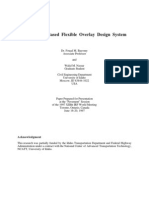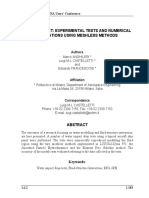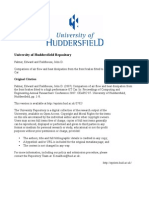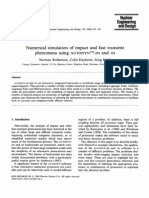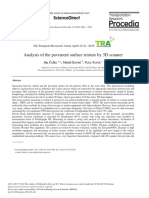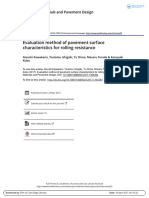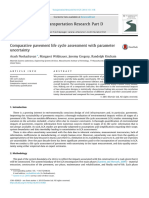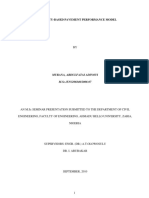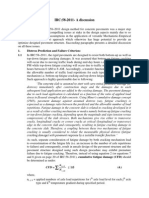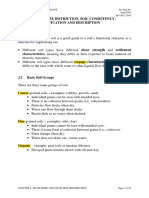Life
Life
Uploaded by
kaiser_m00nCopyright:
Available Formats
Life
Life
Uploaded by
kaiser_m00nCopyright
Available Formats
Share this document
Did you find this document useful?
Is this content inappropriate?
Copyright:
Available Formats
Life
Life
Uploaded by
kaiser_m00nCopyright:
Available Formats
ACCELERATED LIFE CYCLE TESTING
The following diagram illustrates how NATC uses an accelerated life cycle test to simulate 15 years or 250,000 miles in 16 weeks and 30:1 acceleration factor (depending on the service environment of the vehicle). ee e
Road Induced Dynamic Load Effects:
G (n)@V
We
Roughness Profile of Service Environment Velocity on Test Course
Lt = Le
Length of travel on the test course is a function of:
Vt Vt Gee(n1e) Ve Ve Gtt(n1t)
b 2
b S
Slope of stress (S) vs. number of cycles (N) for structural material(s) under test
Gtt(n)@Vt
Velocity in Service Environment
Strain Gage Vehicle natural frequency via strain gage analysis
Wt
Roughness Profile of Test Environment
Environmental Load Effects: Temperature F F
5% NaCl
Rain, Ice & Humidity
Blowing Sand & Dust
Corrosion
Publication List and Technical Description on Reverse Side
NATC offers Accelerated Life Cycle Testing
For more information on NATC's validated accelerated life cycle testing methodology, contact Colin Ashmore or Henry C. Hodges Jr. at 775-629-2000. Additionally, the three publications below, detailing NATC's accelerated testing methodologies are available upon request (NATC, P.O. Box 234, Carson City, Nevada 89702-0234). 1. S.C. Ashmore and H.C. Hodges Jr., Dynamic Force Measurement Vehicle (DFMV) and its Application to Measuring and Monitoring Road Roughness. Vehicle, Tire, Pavement Interface, ASTM STP I 164, J.J. Henry and J.C. Wambold, Eds., American Society for Testing and Materials, Philadelphia, 1992, pp. 69-96. S.C. Ashmore, A.G. Piersol and J.J. Witte, Accelerated Service Life Testing of Automotive Vehicles on a Test Course, Vehicle System Dynamics, Volume 21, Number 2, 1992, pp. 89-108. S.C. Ashmore and J.J. Witte, Accelerated Service Life Testing Conducted with an Automotive Vehicle on a Test Course, Proceedings, Institute of Environmental Sciences, 1993, pp. 134-146.
2. 3.
The first paper discusses how NATC acquires and analyzes road roughness data in terms of a vehicleindependent physical roughness profile and a statistical wave-number spectra [spatial Power Spectral Density (PSD)]. The paper primarily discusses vertical inputs to vehicles; however, NATC also realizes that the longitudinal and lateral inputs are equally important. For example, NATC also defines relative powertrain demands (grades, traction, soft soils and sinkage, washboard, etc.) between environments through longitudinal force measurements with the DFMV. The DFMV is a research tool that has other applications, as briefly discussed in the paper. For example, NATC has been performing off-road anti-lock brake studies utilizing triaxial for measurements with the DFMV. The second and third papers were written as a result of testing for the nuclear transport industry and for prototype vehicles within the commercial market, both domestic and foreign service environments. These papers detail the development of a definitive methodology for scaling energetics between the test and service environments. Whereas the automotive industry design approach is largely evolutionary, NATC developed the approach to design and test a vehicle from the "ground up". On the reverse side is a figure that provides an overview of NATC's accelerated life test methodology. As shown, if the wave-number spectra for the service and test environments are defined in terms of a vehicle-independent measurement, then direct comparisons can be made in engineering terms. As derived in the second paper, mileage equivalencies between service and test environments can be calculated through scaling the wavenumber spectra, vehicle speeds, and a fatigue parameter for the vehicle (and a road-component transfer function). This scaling equation has been validated through several accelerated durability tests and strain gage fatigue analysis tests at NATC. NATC's approach also includes the anticipated level of discrete inputs such as washboard, mud, sand, grades, and impacts (potholes, curbs, etc.). These discrete inputs are run one-for-one, and no attempt is made to accelerate their inputs. Additionally, NATC typically integrates accelerated environmental cycles (high and low temperature, humidity and corrosion) at the beginning, middle and end of the durability testing. The reason for combining the environmental tests is that the service environment has a high probability of interactions or synergistic effects between road induced dynamic loads and environmentally induced loads. This test scenario is designed to account for those interactions.
A Division of Hodges Transportation, Inc. Post Office Box 234, Carson City, Nevada 89702 Tel. 775-629-2000 FAX 775-629-2000 Internet - http://www.natc-ht.com email - info@natc-ht.com
Real Time, Real World Solutions
TM
You might also like
- A2.2 InglesDocument108 pagesA2.2 InglesGUTIERREZ CRUZ RODRIGO INGENIERIA QUIMICA100% (4)
- Working On The YardDocument4 pagesWorking On The Yardapi-309277697No ratings yet
- Full Scale AnalysisDocument43 pagesFull Scale Analysispaulogud6170No ratings yet
- A23 537Document6 pagesA23 537Sunilkumar ReddyNo ratings yet
- Advances in Backcalculating The Mechanical Properties of Exible PavementsDocument11 pagesAdvances in Backcalculating The Mechanical Properties of Exible PavementsArthur Nnang100% (1)
- Mechanistic-Empirical Pavement Design A Brief OverviewDocument8 pagesMechanistic-Empirical Pavement Design A Brief OverviewedgomurNo ratings yet
- Wevj 08 00327 PDFDocument12 pagesWevj 08 00327 PDFsatyavartguptaNo ratings yet
- Comparing Rutting PerformanceDocument20 pagesComparing Rutting Performanceskhan247No ratings yet
- Measurement of Vibrations Affecting The PDFDocument9 pagesMeasurement of Vibrations Affecting The PDFAlejandro Santos MonterrubioNo ratings yet
- A Novel Approach To The Calculation of Pothole-Induced Contact Forces in MDOF Vehicle ModelsDocument36 pagesA Novel Approach To The Calculation of Pothole-Induced Contact Forces in MDOF Vehicle ModelsManjunatha EikilaNo ratings yet
- Riser TestDocument22 pagesRiser TestAbraham RojasNo ratings yet
- Shear Failure Investigation of Unbound Pavement Layers Under Accelerated Heavy Aircraft Loading Case StudyDocument19 pagesShear Failure Investigation of Unbound Pavement Layers Under Accelerated Heavy Aircraft Loading Case StudyShubham DwivediNo ratings yet
- Research Article: A Methodology For Determination of Resilient Modulus of Asphaltic ConcreteDocument7 pagesResearch Article: A Methodology For Determination of Resilient Modulus of Asphaltic ConcreteQuốc KhánhNo ratings yet
- Effect of Interlayer Properties On AC Airfield Pavements Main ResponsesDocument15 pagesEffect of Interlayer Properties On AC Airfield Pavements Main ResponsesJohann CárdenasNo ratings yet
- Tire-Stiffness and Vehicle-State Estimation Based On Noise-Adaptive Particle FilteringDocument17 pagesTire-Stiffness and Vehicle-State Estimation Based On Noise-Adaptive Particle FilteringsuyashNo ratings yet
- Load Transfer of Polycarbonate Blast Resistant Glazing SystemsDocument10 pagesLoad Transfer of Polycarbonate Blast Resistant Glazing SystemsDiego Zenteno CornejoNo ratings yet
- Engineers, Part D: Journal of Automobile Proceedings of The Institution of MechanicalDocument16 pagesEngineers, Part D: Journal of Automobile Proceedings of The Institution of MechanicalAvinash ShindeNo ratings yet
- tp 133-1-13-22Document31 pagestp 133-1-13-22Reginaldo JesusNo ratings yet
- Interpretation of Ow Number Test Data For Asphalt Mixtures: ArticleDocument10 pagesInterpretation of Ow Number Test Data For Asphalt Mixtures: ArticleDr Rajiv KumarNo ratings yet
- Cyclic Load Triaxial Test Procedures For Soils inDocument7 pagesCyclic Load Triaxial Test Procedures For Soils invishal kumarNo ratings yet
- Stochastic Analysis of Thermal Cracking Distress of Asphalt Pavements Using The MEPDG Thermal Cracking ModelDocument9 pagesStochastic Analysis of Thermal Cracking Distress of Asphalt Pavements Using The MEPDG Thermal Cracking ModelAyu Intan NNo ratings yet
- TireDocument1 pageTiremohandgodNo ratings yet
- 2 Dorigatti Evaluation Off Crosswind Effects On Rail Ehicles Through Moving Model Experiments (Pendolino)Document10 pages2 Dorigatti Evaluation Off Crosswind Effects On Rail Ehicles Through Moving Model Experiments (Pendolino)DoicielNo ratings yet
- Ipc2012 90137Document7 pagesIpc2012 90137Marcelo Varejão CasarinNo ratings yet
- UNITEN ICCBT 08 Parametric Study of Environmental Load Impacts On A Jack-UpDocument16 pagesUNITEN ICCBT 08 Parametric Study of Environmental Load Impacts On A Jack-UpBoonme ChinnaboonNo ratings yet
- A Load History Generation Approach For Full-Scale Accelerated Fatigue TestsDocument18 pagesA Load History Generation Approach For Full-Scale Accelerated Fatigue TestsBilu VargheseNo ratings yet
- Impact_of_static_and_dynamic_loads_of_vehicles_on_Document8 pagesImpact_of_static_and_dynamic_loads_of_vehicles_on_Saikaran NarendraNo ratings yet
- Determining Fracture Energy in Asphalt MDocument12 pagesDetermining Fracture Energy in Asphalt MgemmyNo ratings yet
- Aerodynamic Drag of Heavy Vehicles (Class 7-8) Simulation and BenchmarkingDocument21 pagesAerodynamic Drag of Heavy Vehicles (Class 7-8) Simulation and BenchmarkingMarcusHuynh88No ratings yet
- Computational Analysis of Mine Blast On A Commercial Vehicle StructureDocument31 pagesComputational Analysis of Mine Blast On A Commercial Vehicle StructureGerman GoMezNo ratings yet
- Test Rig MethodologyDocument12 pagesTest Rig MethodologyKannanKingmakerNo ratings yet
- Numerical Evaluation of Pavement Design Parameters For The Fatigue Cracking and Rutting Performance of Asphalt PavementsDocument16 pagesNumerical Evaluation of Pavement Design Parameters For The Fatigue Cracking and Rutting Performance of Asphalt PavementsPoornɑ Tejɑ MunɑgɑpɑtiNo ratings yet
- Reveiw Pavt AnalysisDocument11 pagesReveiw Pavt AnalysisSeid AbduNo ratings yet
- Splash and Spray Measurement and Control: Recent Progress in QuebecDocument16 pagesSplash and Spray Measurement and Control: Recent Progress in QuebecAnabelPradoSNo ratings yet
- Sensors 23 06435 v2Document17 pagesSensors 23 06435 v2SAGI RATHNA PRASAD me14d210No ratings yet
- Laboratory_fatigue_assessment_of_large_geocompositDocument10 pagesLaboratory_fatigue_assessment_of_large_geocomposithvthang1981No ratings yet
- Accelerometer PDFDocument18 pagesAccelerometer PDFDidier Yves Putra TebilyNo ratings yet
- Numerical Evaluation of Pavement Design Parameters For The Fatigue Cracking and Rutting Performance of Asphalt PavementsDocument16 pagesNumerical Evaluation of Pavement Design Parameters For The Fatigue Cracking and Rutting Performance of Asphalt Pavements18104900No ratings yet
- Sensitivity Analysis of Rigid Pavement Systems Using MEPDGDocument11 pagesSensitivity Analysis of Rigid Pavement Systems Using MEPDGSyria MostakNo ratings yet
- Icsv28 - Mechanical Impedance Differences Between Driving-Point and Transfer Impedance - 31.03.2022Document8 pagesIcsv28 - Mechanical Impedance Differences Between Driving-Point and Transfer Impedance - 31.03.2022Gianfranco PellicanoNo ratings yet
- Sidy Mactar SOKHNA BPI - Template - 2024Document22 pagesSidy Mactar SOKHNA BPI - Template - 2024Sidy Mactar SOKHNANo ratings yet
- The Influence of Number and Values of Ratios in STDocument11 pagesThe Influence of Number and Values of Ratios in STIsmah ParmigianiNo ratings yet
- Modelling, Simulation and Validation of Results With Different Car Models Using Wind Tunnel and Star-CCM+Document12 pagesModelling, Simulation and Validation of Results With Different Car Models Using Wind Tunnel and Star-CCM+TeresaNo ratings yet
- Development of Hybrid Vehicle Energy Consumption Model - I 2020Document20 pagesDevelopment of Hybrid Vehicle Energy Consumption Model - I 2020ruben rosete hernandezNo ratings yet
- MMMMMMMMDocument13 pagesMMMMMMMMBashir AlsadawiNo ratings yet
- Mechanistic-Based Flexible Overlay Design System: AcknowledgmentDocument8 pagesMechanistic-Based Flexible Overlay Design System: AcknowledgmentAhmed AsimNo ratings yet
- Water Impact: Experimental Tests and Numerical Simulations Using Meshless MethodsDocument12 pagesWater Impact: Experimental Tests and Numerical Simulations Using Meshless Methodsbb06412000No ratings yet
- MWD FailDocument10 pagesMWD Faillulalala8888No ratings yet
- 7 - Paper 5 E Palmer FINALDocument9 pages7 - Paper 5 E Palmer FINALJuzer RangwalaNo ratings yet
- Dynamic Pile Load TestDocument8 pagesDynamic Pile Load Testarno assassinNo ratings yet
- Evaluation Moduli Dynamic: Layer PenetrometerDocument15 pagesEvaluation Moduli Dynamic: Layer PenetrometerHewa Wedage Niroshan AnuruddhaNo ratings yet
- Nuclear Engineering and Design: Numerical Simulation of Impact and Fast Transient Phenomena Using and 3DDocument7 pagesNuclear Engineering and Design: Numerical Simulation of Impact and Fast Transient Phenomena Using and 3DvenkatesanjsNo ratings yet
- Analysis of The Pavement Surface Texture by 2016 Transportation Research PaperDocument10 pagesAnalysis of The Pavement Surface Texture by 2016 Transportation Research PaperAllan SanchezNo ratings yet
- 路面表面滚动阻力特性的评价方法Document11 pages路面表面滚动阻力特性的评价方法jordan jackNo ratings yet
- Comparison of Fracture Test Standards For A Super Pave Densegraded Hot Mix AsphaltDocument14 pagesComparison of Fracture Test Standards For A Super Pave Densegraded Hot Mix AsphaltharNo ratings yet
- UA-Comparative Pavement 2013 NoshadravanDocument8 pagesUA-Comparative Pavement 2013 NoshadravannamiNo ratings yet
- iNEW Method For Experimental-Numerical Locomotive Studies Focused On Rail Wear PredictionDocument15 pagesiNEW Method For Experimental-Numerical Locomotive Studies Focused On Rail Wear PredictionQing WuNo ratings yet
- Friction Coeff Leaf SpringDocument7 pagesFriction Coeff Leaf SpringbennyfergusonNo ratings yet
- Reliability-Based Pavement Performance Model: Murana, Abdulfatai Adinoyi M.Sc./ENG/06840/2006-07Document26 pagesReliability-Based Pavement Performance Model: Murana, Abdulfatai Adinoyi M.Sc./ENG/06840/2006-07prmraoNo ratings yet
- IRC 58-2011 - A DiscussionDocument9 pagesIRC 58-2011 - A DiscussionSanjay GargNo ratings yet
- Atmosphere 12 00436Document23 pagesAtmosphere 12 00436yassine.ouafa2No ratings yet
- Neues verkehrswissenschaftliches Journal - Ausgabe 16: Capacity Research in Urban Rail-Bound Transportation with Special Consideration of Mixed TrafficFrom EverandNeues verkehrswissenschaftliches Journal - Ausgabe 16: Capacity Research in Urban Rail-Bound Transportation with Special Consideration of Mixed TrafficNo ratings yet
- Measuring Angle of Incidence (AOI) Influence On PV ModuleDocument4 pagesMeasuring Angle of Incidence (AOI) Influence On PV ModulemulconioNo ratings yet
- Capm and EmhDocument29 pagesCapm and EmhNguyễn Viết ĐạtNo ratings yet
- Reasoning Cards 4 - Conductors and InsulatorsDocument3 pagesReasoning Cards 4 - Conductors and InsulatorsNisar BetoumiNo ratings yet
- A Preface To Philosophy, Logic & Human ExistenceDocument11 pagesA Preface To Philosophy, Logic & Human ExistenceAyuba oveyNo ratings yet
- MTI Award - Best in Class - Awarding Innovative ProjectsDocument1 pageMTI Award - Best in Class - Awarding Innovative ProjectsMTI Consultancy for Personnel and Organizational DevelopmentNo ratings yet
- What Is Scratch 1611213348 1617187994Document4 pagesWhat Is Scratch 1611213348 1617187994JatadharNo ratings yet
- Flip, The Funny FishDocument12 pagesFlip, The Funny FishWhatdNo ratings yet
- 18/10 25 7:15 Jenny Fields - 0414443552: Your AnswersDocument10 pages18/10 25 7:15 Jenny Fields - 0414443552: Your AnswersHân Đoàn NhưNo ratings yet
- SE GTU Study Material Presentations Unit-3 26092020084433AMDocument51 pagesSE GTU Study Material Presentations Unit-3 26092020084433AMKushal ParmarNo ratings yet
- DB 19 Apr 24 StudentsDocument74 pagesDB 19 Apr 24 Studentspeculiarnyz05No ratings yet
- G12 Final Research PaperDocument57 pagesG12 Final Research PaperIvanAlabaNo ratings yet
- Overview of Oil Types: Data Sheet Commercial CompressorsDocument2 pagesOverview of Oil Types: Data Sheet Commercial CompressorsHendra GunawanNo ratings yet
- Python For Arcgis: Ahmad AburizaizaDocument58 pagesPython For Arcgis: Ahmad Aburizaizaမဒမ် ဇော်No ratings yet
- SYCM Before FinalDocument30 pagesSYCM Before FinalprajwalNo ratings yet
- Determining Inside Hose Stream DemandsDocument1 pageDetermining Inside Hose Stream Demandsمحمد مجديNo ratings yet
- MTL IS Interfaces PDFDocument30 pagesMTL IS Interfaces PDFmasimeriseNo ratings yet
- 1 StudiaArcheologicaBrunensia 22-2017!2!5Document18 pages1 StudiaArcheologicaBrunensia 22-2017!2!5marina šimekNo ratings yet
- Technical Seminar ReportDocument5 pagesTechnical Seminar ReportArun KodagantiNo ratings yet
- Gear Pump Screw Pump Lobe Pump Flexible Vane or Sliding Vane Flexible Impeller Liquid-Ring Pumps Piston Pumps Plunger Pumps Diaphragm Pumps Rope Pumps Chain PumpsDocument1 pageGear Pump Screw Pump Lobe Pump Flexible Vane or Sliding Vane Flexible Impeller Liquid-Ring Pumps Piston Pumps Plunger Pumps Diaphragm Pumps Rope Pumps Chain PumpsbassamNo ratings yet
- DLL MIL QUARTER 2 WEEK 6Document4 pagesDLL MIL QUARTER 2 WEEK 6cristalNo ratings yet
- Day Wise Academic Planner of Intensive Program For NEET-2024Document3 pagesDay Wise Academic Planner of Intensive Program For NEET-2024varungore1No ratings yet
- End-Module Assignment: Tiki AnalysisDocument12 pagesEnd-Module Assignment: Tiki AnalysisTrọng LinhNo ratings yet
- Mar - Abc-Ff-001Document73 pagesMar - Abc-Ff-001riyazNo ratings yet
- CON4341 - E - Note - 03 PSD, Consistency, DescriptionsDocument22 pagesCON4341 - E - Note - 03 PSD, Consistency, Descriptions123No ratings yet
- 395-Article Text-1362-2-10-20220720Document13 pages395-Article Text-1362-2-10-20220720PipingNo ratings yet
- 2024 5.2 S3 Salt Assignment StudentDocument4 pages2024 5.2 S3 Salt Assignment StudentmartinfunjwNo ratings yet
- NTSE Haryana 2019 20 MAT C Question PaperDocument49 pagesNTSE Haryana 2019 20 MAT C Question PaperKeshav YadavNo ratings yet








